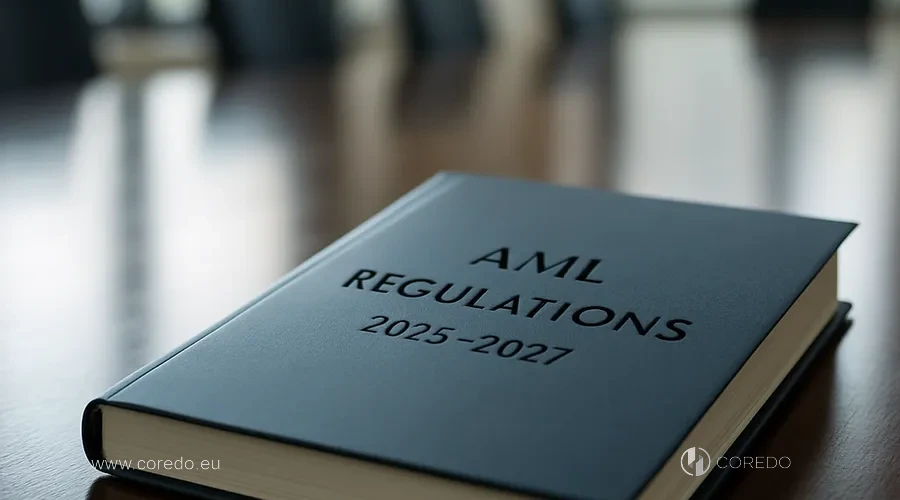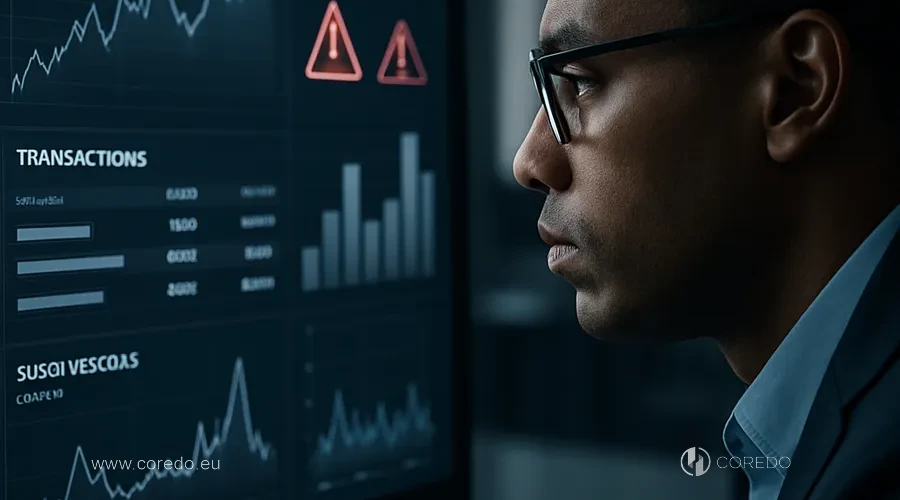For companies operating in the EU, this is not only a legal obligation but also a key factor of trust from partners, banks and investors. The practice of COREDO confirms: the absence of transparent Customer Due Diligence (CDD) procedures and an ineffective risk-based approach lead to account freezes, denial of service and even criminal liability.
Key concepts of AML, KYC, Compliance
At the core: KYC procedures (Know Your Customer), including identification, verification and ongoing monitoring of clients. Compliance in Europe: it is not only about meeting formal requirements, but also about creating an internal culture where risk management is integrated into every business operation.
Objectives of countering money laundering in the EU
To this end, the EU implements unified standards, guided by FATF recommendations and strengthens control over cross-border transactions, crypto-assets and new digital services.
EU Regulatory Requirements on AML 2025–2027

At the center of these changes are tighter controls and the harmonization of processes based on updated legislative acts, such as 6AMLD and the new AML Regulation.
Key legislative acts: 6AMLD and the AML Regulation
From 2025, key changes come into force: 6AMLD (Sixth Anti-Money Laundering Directive) and the new AMLR (EU Single Rulebook). These documents unify rules for all EU countries, introduce clear criteria for identifying beneficiaries, expand the list of obliged entities and strengthen requirements for the compliance regulatory framework.
Role of the European Anti-Money Laundering Agency and launch timelines
From 2026, control over compliance will transfer to the European Anti-Money Laundering Agency (AMLA), which will become the centralized supervisory authority. The solution developed by COREDO for clients already takes into account new procedures for interacting with AMLA, including preparation for centralized inspections and unified reporting.
Expansion of persons and sectors under AML supervision
Now under AML control are not only banks and payment organizations, but also crypto platforms, marketplaces, digital wallet providers, as well as services working with digital identification. In a recent COREDO project for a fintech company from the Czech Republic we integrated cross-border compliance taking into account the new requirements for providers of virtual assets.
Impact of MiCA on AML in crypto-assets
With the adoption of the MiCA Regulation (Markets in Crypto-Assets), crypto companies are required to implement full KYC/KYT procedures, transaction monitoring and automated risk analysis. Our experience at COREDO has shown: adapting internal policies to MiCA and AMLR not only helps avoid fines but also increases trust from European banks.
KYC procedures 2025: how to meet the requirements

It becomes critically important for businesses to comply with the new KYC requirements in order to preserve reputation, avoid fines and operate successfully in the market amid increasing international regulation.
Overview of KYC procedures in AML compliance
KYC procedures: the fundamental element of AML compliance for businesses. They include collecting and verifying client data, analyzing sources of funds, monitoring transactions and detecting suspicious activity. Without clear KYC processes it is impossible to ensure compliance with the new EU standards.
New KYC standards 2025: eKYC and onboarding
From 2025 the focus shifts to eKYC and digital onboarding: digital identification, remote verification of clients and integration with state registers (eIDAS). Solutions implemented by the COREDO team for clients in Estonia and Slovakia allow reducing verification time from several days to hours, cutting costs and increasing conversion.
Enhanced due diligence: risk-based approach
For clients from high-risk jurisdictions or when working with large transactions Enhanced Due Diligence (EDD) is applied. This is an in-depth check of sources of funds, ownership structure and links to politically exposed persons. In one of COREDO’s case studies for a British investment platform we implemented a risk-based approach with automatic reassessment of the risk level whenever the client’s profile changed.
KYC automation and analytics integration
Modern KYC procedures are impossible without automation.
At COREDO we assess the ROI from implementing such solutions by reducing manual errors and accelerating compliance processes.
Transaction monitoring and AML: practical aspects

Transaction monitoring and fulfilling AML reporting obligations are key elements of the system to combat financial abuse in modern business. Practical aspects of this work include continuous risk assessment, monitoring of transactions, and preparing reports in accordance with regulators’ requirements. Below we review the main requirements for transaction monitoring and identifying suspicious activity.
Transaction monitoring and detection of suspicious activity
Transaction monitoring: the key to timely detection of suspicious transactions. In 2025 the requirements for automated analysis are rising: systems must not only flag anomalies but also explain the logic behind their decisions (explainable AI). In COREDO’s work for a platform in Dubai we deployed a module that uses graph neural networks to uncover complex chains of transactions among related parties.
AML obligations: deadlines, forms, liability
Companies must file reports on suspicious activities (Suspicious Activity Reporting) to national FIUs (Financial Intelligence Units) within 24–48 hours of detection.
COREDO’s solution includes automation of report generation and integration with government portals.
Use of graph neural networks and confidential machine learning
The implementation of confidential machine learning (FHE) and continual learning enables analysis of large volumes of data without exposing personal data, which is critical for GDPR compliance. For example: for an international payment provider, the COREDO team implemented a collaborative risk analysis with partners from different countries without transferring raw data, using homomorphic encryption technologies.
Interaction with FIUs and sanctions control
At COREDO we set up automatic checks of customers and transactions for matches against sanctions lists, minimizing the risk of inadvertent violations.
Fines for AML non-compliance: how to avoid them

Failure to comply with AML requirements entails serious fines and risks for businesses — from financial sanctions to a complete suspension of activity. To avoid sanctions, it is important to understand what types of liability are provided by law and how they are applied in practice.
Main fines for AML violations in the EU
Since 2025 the minimum fine for violating AML in the EU is €1 million or 10% of the company’s annual turnover, depending on which amount is higher. For repeat violations, executives may face criminal liability.
Examples of global investigations and cases
COREDO’s practice shows: regular compliance regulatory audits and stress-testing of internal procedures make it possible to identify vulnerabilities before regulators take interest.
The impact of 6AMLD on stricter liability
6AMLD expands the list of predicate offences, introduces the concept of “aiding and abetting,” and tightens the standards for proving guilt. Liability now extends not only to the company but also to specific employees involved in violations. At COREDO we adapt clients’ internal regulations to the new standards, reducing the risk of personal liability for executives.
Managing compliance risks in business
Effective compliance risk management requires not only the implementation of technology but also regular staff training, procedure reviews, and independent audits. COREDO’s solution includes checklists for assessing the maturity of the compliance system and tools for rapid incident response.
Implementing AML compliance in a company: recommendations

Implementing AML compliance in a company requires a systematic approach and a clear understanding of current regulatory requirements. Practical recommendations will help adapt internal regulations to the new EU rules and the 6AMLD, ensuring effective anti-money laundering and legal compliance.
Adapting regulations to EU requirements and the 6AMLD
The first step is reviewing and adapting internal policies in accordance with the 6AMLD and AMLR. The COREDO team develops tailored compliance programs, taking into account industry specifics, business structure and the geography of operations.
Scaling and automation of compliance processes
Scalability is a key challenge for fast-growing companies. Automation of KYC, transaction monitoring and reporting reduces costs and increases the speed of response to incidents. In one of COREDO’s projects for an international marketplace we implemented a compliance workflow integration module, which made it possible to process three times more clients without increasing headcount.
Training staff in a culture of compliance
Effective compliance training: not a one-off event, but an ongoing process. At COREDO we pay special attention to developing a compliance culture: regular training sessions, incident simulations, and experience sharing between departments. This reduces the risk of human error and fosters a responsible approach to risk management.
ROI of implementing AML systems: cost savings and risk reduction
Implementing modern AML systems is an investment with measurable ROI. In COREDO’s case for a payment provider from Cyprus, the automation of KYC and monitoring reduced operating costs by 40% and cut client processing time from 2 days to 30 minutes. But most importantly, the minimization of the risk of fines and account blocks, which ensures business resilience in the long term.
AML compliance in the EU: key steps
In the context of tightening regulatory requirements, AML compliance in the EU is becoming a key issue for businesses. New directives, the digitalization of procedures and greater transaction transparency require not only formal fulfillment of obligations but also real implementation of advanced compliance standards. Below are the key findings and practical steps that will help entrepreneurs and executives prepare for changes and ensure the sustainable development of the company.
Recommendations for entrepreneurs and managers
- Conduct an audit of current procedures and identify gaps in compliance with 6AMLD and AMLR.
- Implement digital KYC and automated transaction monitoring.
- Organize regular staff training and stress-testing of the compliance system.
- Use modern analytics platforms to detect complex money laundering schemes.
Heading analysis
Preparing for new AML requirements
- Assess the maturity of the compliance system using the COREDO checklist.
- Update internal regulations and implement eKYC, digital onboarding.
- Integrate automated monitoring and reporting tools.
- Set up cooperation with FIUs and sanctions lists.
- Regularly review procedures taking into account changes in EU legislation.
How to choose a partner for legal support and compliance?
When choosing a partner, pay attention to experience with international projects, availability of case studies on AML system implementation, expertise in adapting to different jurisdictions and the ability to integrate technologies (Chainalysis, Elliptic, GNN). COREDO’s practice is not only consulting, but also comprehensive end-to-end implementation of compliance processes.
Useful resources and AMLA contacts
- Official AMLA portal: current requirements, reporting forms, recommendations for businesses.
- EU Beneficial Owners Register: for checking ownership structures.
- Platforms for monitoring sanctions and risks: Chainalysis, Elliptic, international FIUs.
Table of changes to AML requirements under the directives
| Aspect | Previous directives | New EU AML Regulation and 6AMLD | Practical implications for businesses |
|---|---|---|---|
| Supervision | National | Centralized through AMLA | Unified standards, enhanced oversight |
| Obliged entities | Banks, insurers | Expanded list (crypto, platforms, etc.) | More obligations for new sectors |
| KYC procedures | Standard | eKYC, digital onboarding, EDD | Adoption of digital technologies and automation |
| Liability and penalties | Less strict | Tightening under 6AMLD | Risks of large fines and criminal liability |
| Monitoring and reporting | Fragmented | Unified, with expanded monitoring | More frequent and detailed reports |
The solutions that the COREDO team implements for clients in Europe, Asia and the CIS not only enable compliance with the new requirements, but also create a resilient, transparent and scalable business ready for future challenges.